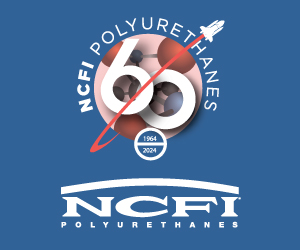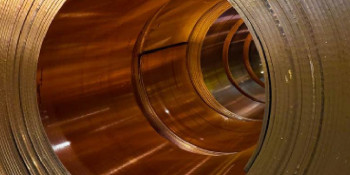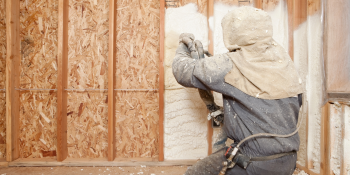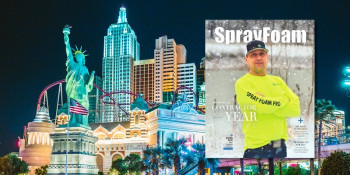Q&A Forums
Maximun thickness Post New Topic | Post Reply
| Author | Comments |
|---|---|
|
Posted: Jun 19, 2006 10:57 AM
|
Maximun thickness
I am a builder in NYS, & have used closed cell insulation with great success. I am now close to releasing the contract for a new closed cell job when I was told that the particular product could not be sprayed more than 3” thick, another 4”. I have a conditioned attic & was planning to spray the underside of the roof at 6” as I need R-38 according to my plans. Now that I have read NYS Residential Code in detail, which stated that, all insulations must have ASTM E-84 rating. I’ve read several foam manufactures specification sheets & most have maximum tested thickness to meet ASTM E-84. I have spoken to 2-3 Manufacturer representatives with most stating that they cannot condone or recommend spraying more then the maximum tested. What’s the deal with the maximum thickness? How is anyone getting to R-30 & above?
|
|
Gerry Wagoner
Posted: Jun 19, 2006 06:53 PM
|
The new 245fa blowing agent is the enemy. The concern is that spraying greater thicknesses will cause excessive heat build-up within the foam and lead to internal charring. Worst case scenario is where a house allegedly caught on fire from this. This is of course, an abstract example, not the norm. You might check some of the alternative foams for maximum one-pass application thickness. Apex 1.2 for instance, and NAP 1.6. Or, just spray in two passes. hope that helps, gcw |
|
Melvin Chandler
Posted: Jun 19, 2006 10:31 PM
|
Why not go open cell? One or more manufacturers has the approval to spray 5.5 under the deck per ICC, Boca, and others. Should the builder really be concerned with R-value? According to the R-myth or one of the other stories about foam, it was said that there is no real advantage for spraying more than 5" of foam. I am Newby and I am still learning. |
|
Posted: Jun 20, 2006 10:22 AM
|
Thanks for the insight. My understanding is that maximum thickness is maximum thickness, whether you achieve it in 2 or more passes. It is the total thickness recommended & condoned by the spray foam manufactures. You can only spray 1"-2" thickness per pass for just the reason you stated. At that point I would need 2 passes to get to the manufactures stated 4" maximum thickness, R-value around R-25. The same goes for open-cell @ R-3.81 per inch with maximum 5.5” is only R-21. This still leaves me well below the R-value required by the Energy Conservation Construction Code of NYS. This ECCC of NYS states the Heating Degree Day for my area & gives a corresponding R-value for the Ceiling/Roof. The R-myth and what ICC, BOCA & others have accepted doesn’t matter until NYS approves & either amends or issues a new Codebook. My inspector requires documentation that reflects how I achieve the required R-value. Whether I agree with R-value or not I’m stuck with it. The NYS Code is my reality. Now after selling my client on the benefits of spray foam over fiberglass batt insulation I may well wind up installing fiberglass over the spray foam just to meet code. How silly it that? I was wondering how spray foam contractors handled this for other builders? |
|
Posted: Jun 20, 2006 10:22 AM
|
Thanks, see above reply |
|
Ryan Rhoads
Posted: Jun 20, 2006 03:12 PM
|
I maybe mistaken by my understanding is that you may have a total thickness of what every you desire; however you can only spray up to 2 inches thick in a single pass. So if you wanted say 6" total thickness then simply spray in 3 or more passes. Around here it is common to spray anywhere from 4" to 6" total depth on potato wharehouses. We do this all the time and I personally have never experianced a problem as long as I don't spray more than 2" thick passes. I normally get about 1.5" thick passes with my bigger tip so I don't worry to much about it. One thing that I have experianced however is that when I spray 1/2 lb foam I will sometimes get bubbles or air gaps that I don't particularly care for. I have never had a problem witht he 2 lb foam and have sprayed a total depth of up to 8". |
|
Ryan Rhoads
Posted: Jun 20, 2006 03:17 PM
|
sorry for the horrible spelling I am in a hurry. |
|
Posted: Jun 21, 2006 12:12 PM
|
Thanks again to everyone for the feedback. I have spoken to three different spray foam manufacturers. One stated flat out that you couldn’t spray more than the maximum tested thickness & maintain ASTM E-84 rating. The other stated that they do not recommend or condone spraying more than the tested thickness. The third believed their product would possibly continue to rate ASTM E-84, but only tested to 4”, with no additional testing scheduled. . Again, I am only referring to NYS Code requirement that insulation pass ASTM- E84 testing (less than .25 smoke spread & less than .450 smoke developed). From the data I have received you can only spray to the maximum thickness indicated in the Product Data Sheet no matter how may passes you take to get to that thickness. I think this is important information to get out to the Spray foam contractors, before we all get into a liability situation. |
|
Posted: Jun 24, 2006 07:13 AM
|
i had a supplier use this cliche... "live and die by the legacy report" we apply to design spec r values... we use the appropriate product for the projects specifications,,,useing the least expensive products whenever possible... |
|
Posted: Jun 27, 2006 05:11 PM
|
I recently was at a spray foam seminar that touched on the subject and yes any rigid foam exceeding 3" in thickness is not technically code approved. It has nothing to do with the application.It does not meet ASTM-E84 when it is in excess of 3". |
|
Dave Strnad
Posted: Jun 27, 2006 07:34 PM
|
Does this include all of the variations .5 LB 1.2 LB, 2 lb etc. Seems like the thing to do is ask the inspector what they want to see, not that they are going to look in the attic anyway. How important is the ASTM-E84 when the inspector just wants to see how you reach a specific R-value. I can't believe that every product out there is tested to every possible thickness or combination. What's a guy supposed to do? |
|
Posted: Jun 29, 2006 08:44 AM
|
the inspectors do look in attics,,especially when they hear foam is in the structure.. the ASTM-e84 is important ..the concern is flame spread,,,dripping of the plastic foam as it melts/combusts,,and the smoke... it is good to communicate with your inspectors and see what their interpetation and requirements are before you apply....get the interpetation in writeing if you can,,, enjoy |
|
francis poplawski
Posted: Jun 29, 2006 09:51 AM
|
if the max. thickness of sprayed in place foam is 3"-4", how is iy that i can buy sips with either open or closed cell foams with the same densities ip to 7 1/4", 9 1/4" & more? |
|
Posted: Jun 29, 2006 12:37 PM
|
Sprayfoam1 you are the only one to get what I am talking about. Thanks! The reason I asked this question is that I am always concerned with the liability I/we might be exposed too. If we were to consider the worst-case scenario; say that a recently completed house has a fire & the insurance company sends an inspector to investigate, it would be my luck that the client would be denied insurance payment based insulation sprayed to a greater thickness then tested & approved for a Class 1 rating. That client has been relying on me for my professional knowledge; me as the General Contractor rely on you the Spray Foam Contractor to know the limits of the products you sell. Now I may be sued by the client & in turn have to sue the spray foam contractor, destroying the relationships among the parties. By the way, there are spray foams approved (ASTM E-84) up to 4" thick, but none thicker that I have found to date. |
|
Posted: Jun 29, 2006 02:30 PM
|
DaveS, I am only speaking about closed-cell spray foam insulation. The 0.5 lb open-cell that I am familiar with has been tested & approved (ASTM E-84) up to 6" thick. This particular manufacturer has done the required testing up to 10-1/2" & is waiting the ICC Evaluation Service Report. You asked, "How important is the ASTM E-84", please lookup Insulation in your codebook, R320.1 in mine. This section states that all insulation & components must have ASTM E-84 testing. There are exceptions so read the entire section. I do agree with speaking with the inspector to see what he is expecting. There are some Bldg Insp. that are open minded & look for performance not just R-value. Please note that the R-values have dropped with the most recent blowing agent, only use the aged R-value probably around 6.2 per inch now. As far as testing for different thickness, I heard that this testing is very expensive. I’m sure they do their own testing & have a very good idea what will pass & what won’t. If they were to test at a thickness that failed, they would not have a product to sell. |
|
Posted: Jun 29, 2006 03:35 PM
|
This is an excellent question! I had to call one of the foam manufactures for the answer. The foam in SIP’s is completely different then the foam sprayed on the site. Also, the entire SIP assembly is tested to ASTM E-84 & should have a stamp indicating so. If you see a SIP without that stamp, don't use it. |
|
Gerry Wagoner
Posted: Jun 30, 2006 06:52 PM
|
Could you use a hybrid combination of closed-cell & open cell to achieve your desired R-value? The recent spray foam magazine showcased a fancy house with a theater room where the contractor used 3" of rigid and 5" of open-cell in the wall assembly. See page 35 of July 2006 Spray Foam magazine. Sorry for not understanding your question at first. I have 6" of rigid in our own home's cathedral ceilings, but the building inspector in our county comes to me for insulation information, so I had no trouble whatsoever with him. gcw |
|
Posted: Jul 01, 2006 09:31 AM
|
"The foam in SIP’s is completely different then the foam sprayed on the site." It is Expanded polystyrene EPS EPS is an inert, organic, recyclable material. It contains no CFC's, HCFC's, or HFC's, will not rot, is resistant to mildew, and provides no food value to animals (including rodents). UL tests on most EPS exhibits a flame spread of 5. The BOCA Code allows 75. EPS exhibited a smoke developed rating of 55 to 175. The BOCA Code allows 450... This is from a panel manufacturers tech data... |
|
Posted: Jul 17, 2006 10:15 AM
|
Sorry for the delayed response. Yes I do plan on a hybird installation: 3" of rigid & minimun of 2" of spray applied fiberglass as my fire barrier. Depending on the rigid foam I use I may go to 4" thick & if my bldg insp requires it add to the fiberglass to bring it up to the required R-value. BTW: Thanks for mentioning Spray Foam Magazine, I had no idea that existed. Is there a webpage for this mag? And, the contractor for that theater room may have used the hybird for two reasons: the closed-cell for insulation value & the open-cell for it insulation & more importantly its acoustic value. I have done this in the past. Thanks again |
|
Timothy Sonney
Posted: Jul 17, 2006 12:03 PM
|
Here is the page for Spray Foam Magazine |





























